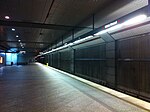Bullocks Wilshire
1929 establishments in CaliforniaArt Deco architecture in CaliforniaBullock'sCommercial buildings completed in 1929Commercial buildings on the National Register of Historic Places in Los Angeles ... and 12 more
Defunct companies based in Greater Los AngelesDefunct department stores based in Greater Los AngelesDepartment stores on the National Register of Historic PlacesHistory of Los AngelesJohn and Donald Parkinson buildingsKoreatown, Los AngelesLos Angeles Historic-Cultural MonumentsMacy'sMid-Wilshire, Los AngelesPages containing links to subscription-only contentTowers in CaliforniaWilshire Boulevard

Bullocks Wilshire, located at 3050 Wilshire Boulevard in Los Angeles, California, is a 230,000-square-foot (21,000 m2) Art Deco building. The building opened in September 1929 as a luxury department store for owner John G. Bullock (owner of the more mainstream Bullock's in Downtown Los Angeles). Bullocks Wilshire was also the name of the department store chain of which the Los Angeles store was the flagship; it had seven stores total; Macy's incorporated them into and rebranded them as I. Magnin in 1989, before closing I. Magnin entirely in 1994. It is currently owned by Southwestern Law School.
Excerpt from the Wikipedia article Bullocks Wilshire (License: CC BY-SA 3.0, Authors, Images).Bullocks Wilshire
Wilshire Boulevard, Los Angeles Koreatown
Geographical coordinates (GPS) Address External links Nearby Places Show on map
Geographical coordinates (GPS)
| Latitude | Longitude |
|---|---|
| N 34.06161 ° | E -118.28827 ° |
Address
Southwestern Law School Bullocks Building (Bullocks Wilshire)
Wilshire Boulevard 3050
90005 Los Angeles, Koreatown
California, United States
Open on Google Maps





